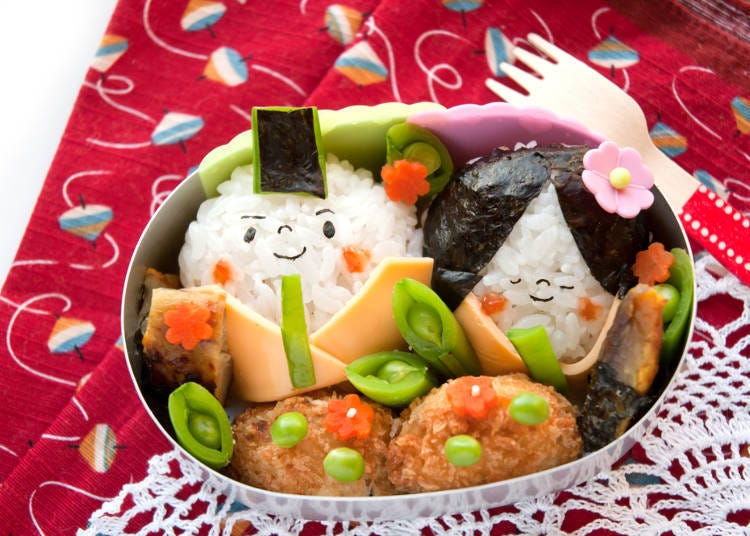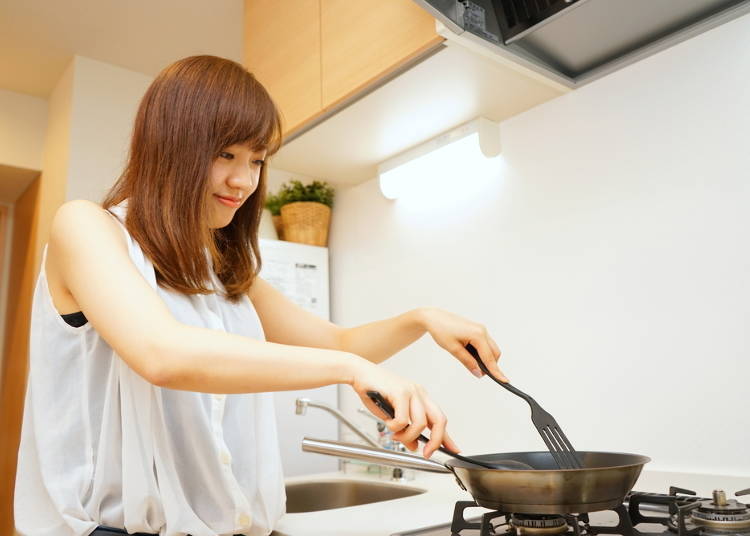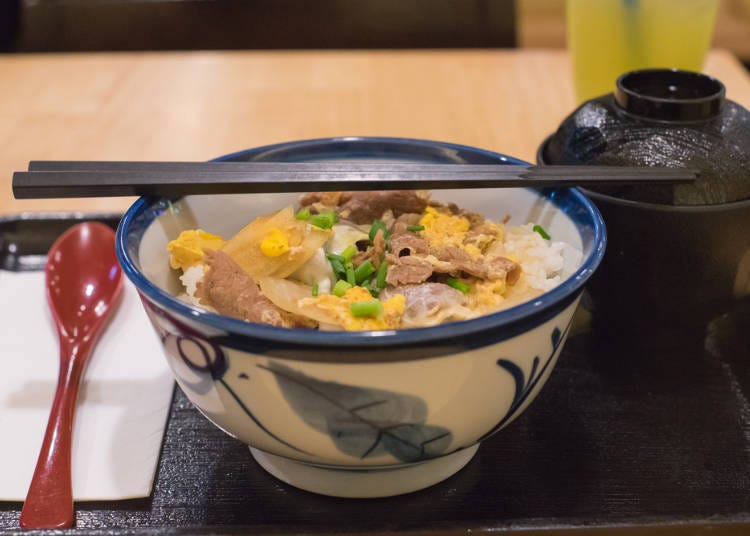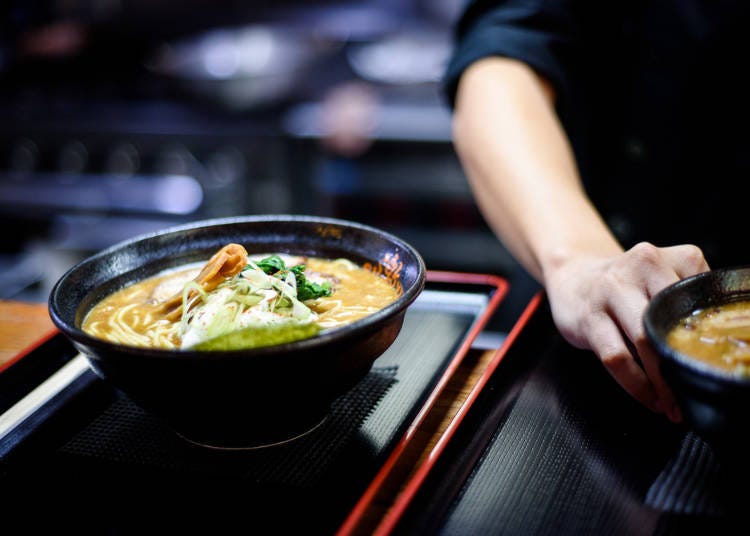
For both Japanese students and workers, lunch marks a time of rest and recovery in the middle of a busy day. Especially in Tokyo, the choice of food seems overwhelming: fast food, cafés, convenience store lunches, beef bowls, curry...? So how do Japanese people spend their lunch break and what do they eat?
Do Wives Really Make Bentō for their Husbands Every Day?

A common stereotype that comes to people’s mind when thinking about Japanese lunch is the one of the housewife preparing a boxed lunch called bentō for her husband. These bentō actually have a special expression in Japanese—aisai bentō, or “boxed lunch made with love and care by one’s wife.” An internet survey conducted by the Asahi Aoyama Happy Research Group (which we’ll call Hapiken) showed that 31.5% of men ate boxed lunches made either by themselves or their partner. Such homemade bentō aren’t just tasty, they also make for a more balanced meal than those bought at cafeterias. Since you know what you’re eating, regarding ingredients and so on, it is considered a safer choice for calorie counters than eating out.
The second-most popular lunch option was to buy a bentō at a convenience store or specialty shop, boasting 25.6%. The main reason for buying a readily-made bentō is that people don’t have the time to enjoy a proper lunch, so they buy it somewhere nearby and eat it at their workplace. Eating out at a restaurant and so on took third place with 24.8%. Judging from these results, it’s rather obvious that people feel too busy for a full lunch break, so a lot of them eat their meal at their office desks.
30% Of Female Office Workers Make Bentō for Themselves

According to Hapiken’s survey, 58.8% of women said that they cook and eat lunch at home. The majority of them are housewives. Most of them have said to usually eat lunch by themselves, using the leftovers from dinner and whatever ingredients are in the fridge. Women working outside of their home also tend to go home for lunch, if their workplace is nearby. The answer that took second place in the ranking was that 29.9% of Japanese working women bring a bentō for lunch. Most Japanese companies offer a microwave, so people queuing up in front of it around noon is a common sight.
Traditionally, married women make boxed lunches for their children and husband from leftover ingredients. A lot of married women also say that making a bentō that both looks fancy and boasts great nutritional value is a daily task. A lot of creative and unique bentō ideas featuring popular characters or animals were born from this challenge.
Why Does Everyone Eat Homemade Bentō?

The majority of both men and women bring their own homemade lunch to work. However, that does take time, so why do so many people choose to cook? Hapiken’s survey states that with 42.7%, the main reason is to save money. Eating out isn’t cheap in Japan, it usually costs between 500 and 1,000 yen. If you do that every day, it becomes quite a hefty sum. Besides, if you make your lunch at home, you can decide the ingredients yourself, ensuring that your diet is healthy and well-balanced.
Nowadays, soups and side dishes can easily be bought at any supermarket, so making your own bentō has become much easier and quicker. In the past, cooking everything from scratch took forever, but with the convenience of modern days, more and more people opt for homemade lunches again.
Eating Out: What Do Japanese People Eat?

Of course, plenty of people also go to a café or restaurant during their lunch break. But what are the trends, in that regard? For short lunch breaks, the majority of people said that their main criterion is speed—how fast is the dish served that they ordered? If the food is served quickly, the turnover rate is also good, and the queuing time is short.
The second most popular criterion was whether a restaurant has a daily-changing menu, while nutrition and food safety ranked third. Again, a major factor when it comes to spending one’s lunch break at a restaurant is time and thus whether the lunch fits into a busy schedule.
Asking the Men: What Do You Order?

For men, soba and udon rank first when it comes to what they order during their lunch break. Set meals take second place and ramen ranks third. The reason why soba and udon are the male worker’s favorite food is because these noodle dishes are cheap while also tasty, filling, and quickly made. Set meals, called teishoku in Japanese, come in second with the main dish accompanied by rice, soup, and various other sides for a very reasonable price. The offers usually vary daily, so that’s a big plus as well. Ramen take third place, but also are the prime answer for particularly short breaks, as a bowl of ramen is quickly served and finished.
Asking the Women: What Do You Order?

Compared to their male colleagues, Japanese ladies’ lunch habits for restaurants are entirely different. Their top three ranking is family restaurants, Italian restaurants, and fast food stores. A lot of Japanese women don’t go to ramen or set meal restaurants by themselves, so for lunch, they also choose restaurants where they feel comfortable being alone. Family restaurants, the number-one answer, boast a rich variety regarding the menu, there usually is a drink bar, and are child-friendly as well. Whether with friends or alone, the family restaurant is a place where Japan’s women can relax.
Coming in second are Italian restaurants because their atmosphere is quiet and comfortable. Stylish menu and interior also play a role. Interestingly enough, the men’s top three was Japanese cuisine, while the women prefer Western restaurants.
How Much Money Do Japanese People Spend on Their Lunch?

For those who want to save, the amount of money spent on lunch is a big topic. Of the 58% of people saying that they eat out for lunch, 20% said that they spend “under 500 yen” on one meal. In Japan, 500 yen is one coin, so for a lot of people, the image of having “lunch for one coin” is important. Another 32.8% said that they spend between 500 and 1,000 yen and indeed, a lot of restaurants offer special lunch menus in that price range. Around Tokyo Station and Marunouchi, there are numerous office buildings and some ethnic and Chinese restaurants have food carts selling boxed lunches. It’s tasty, convenient, and quick, so a lot of workers flock to those carts during lunchtime. Tourists can save some money and get a tasty meal just as much!
The Very Short Lunch Break of Japanese Workers
The trend in Japan definitely goes towards short and quick lunch breaks. With a tight, busy schedule, nutritional value and speed are the two most important criteria when it comes to lunch choices. Sitting down and eating a meal in a calm and relaxed manner, on the other hand, seems to be a bit of a challenge.
- Area
- Category
*Prices and options mentioned are subject to change.
*Unless stated otherwise, all prices include tax.
Popular Tours & Activitiess
Recommended places for you
-

Tokyo City Pass Upgrade: Harry Potter Studio Tour & Top Sights up to 85% Off
by: Guest Contributor
-

Enjoy Japan's Gorgeous Winter Lights! Ride the Romancecar to Shonan no Hoseki Illumination
by: Guest Contributor
-

Simply Oishii Wagashi School Discover Japanese Culture Through Wagashi: A Hands-On Experience!
by: Guest Contributor
-

The Best Japanese Food Representing 2025! 'Dish of the Year®' Annual Award Results Announced
-

Don't Miss Out! The One Thing You Must Do Before Shopping at Mitsui Shopping Park LaLaport: Get Your Max 10% OFF Coupon Book
-

New Seibu L00 Series Launching in 2026! What to See Along the Tokyo-Area Golden Route
by: Guest Contributor
Inspiration for Accommodations
-

Enjoy Mt. Fuji from the Comfort of Your Room! Recommended Ryokan with Mt. Fuji View
-

Stay Near the Cherry Blossoms! Hotels for Cherry Blossom Viewing in Tokyo
-

Family-Friendly Hotels with Free Shuttle to Disneyland: Convenient Access for a Magical Stay
-

Top Ranked Hakone Hotels with Mt. Fuji View: Enjoy Stunning Scenery from Your Private Space
-

Convenient Tokyo Hotels with Airport Shuttle: Ideal for Families and Heavy Luggage
-

Stunning Tokyo Tower View Hotels: Enjoy Spectacular Scenery from Your Private Space
-

Convenient Asakusa Hotels with Kitchens: Ideal for Extended Family Visits
-

Experience Luxury: Hakone's 10 Best Five-Star Accommodations
-

Enjoy Mt. Fuji Autumn Leaves! Top Hotels Near the Popular Autumn Leaves Corridor
-

Experience Hakone Fall Foliage from Your Room with Stunning Views
-

Complete Guide to Buying Japanese Medicine in Japan: Phrases and Vocabulary You Need to Know
-

Ekiben Excellence: Japan's Most Fascinating Train Station Bentos!
-

Tokyo Roppongi|Roppongi Station Area Map & Sightseeing Information
-

How to Make Bento for Beginners: 3 Big Rules and Easy Tips & Tricks! (Video)
-

Kichijoji – Explore Tokyo’s Top-Rated Stylish Suburb in Half a Day!
-

The Ins and Outs of Everyone’s Favorite Train Bento
- #best ramen tokyo
- #what to buy in ameyoko
- #what to bring to japan
- #new years in tokyo
- #best izakaya shinjuku
- #things to do tokyo
- #japanese nail trends
- #what to do in odaiba
- #onsen tattoo friendly tokyo
- #daiso
- #best sushi ginza
- #japanese convenience store snacks
- #best yakiniku shibuya
- #japanese fashion culture
- #best japanese soft drinks


















